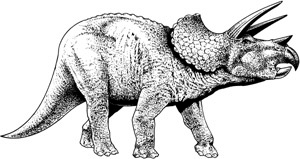Post by Barry the Baryonyx on Jun 27, 2007 19:49:53 GMT -5
Triceratops

Pic © University of California Museum of Paleontology
Triceratops - tri ser' a tops - meaning 'three-horned face' (derived from the Greek tri -/ meaning 'three', ceras/ meaning 'horn' and meaning 'face') was a ceratopsid herbivorous dinosaur genus, from the Late Cretaceous Period (from around 70-65 million years ago) of what is now North America. It lived at around the same time and place as Tyrannosaurus, Ankylosaurus and another well-known ceratopsid, Torosaurus. Although no complete skeleton has been found, it has been estimated that Triceratops was about 9 m (30 ft) long, 3 m (10 ft) tall, and weighed around 5,400 kg (12,000 lb).
Discoveries and species
Triceratops was discovered by John Bell Hatcher, in 1888. Its declaration as a legitimate dinosaur came when an intact skull was found. It was named by Othniel Charles Marsh in 1889 (some time earlier, however, in 1887 near Denver, Colorado, USA, he had misidentified the Triceratops as a type of bison, giving it the name Bison alticornis). The sturdy nature of the animal's skull has ensured that many examples have been preserved as fossils, allowing variations between species and individuals to be studied. Triceratops remains have subsequently been found in Montana, South Dakota, and Wyoming, in the USA and in Saskatchewan and Alberta, in Canada.
How many species?
In the first decades after Triceratops was described, various skulls were collected, which varied to a lesser or greater degree from the original Triceratops, named T. horridus by Marsh (from Latin horridus; "rough, rugose", suggesting the roughened texture of the bones, which Marsh later admitted belonged to an aged individual). Discoverers would write these up as separate species (listed below). Eventually, however, the idea that the differing skulls might be representative of individual variation within one (or two) species gained popularity. In 1986, Ostrom and Wellnhofer published a paper where they proposed there was only one species - Triceratops horridus. Part of the rationale is that generally there are only one or two species of any large animal in a region (e.g. elephant or giraffe in modern Africa). A few years later, Cathy Forster reanalysed Triceratops material more comprehensively and concluded that the remains fell into two species, T. horridus and T. prorsus, although the distinctive skull of T. (now tentatively Diceratops) hatcheri differed enough to warrant a separate genus.
Paleobiology
Although Triceratops is commonly portrayed as a herding animal, there is currently no solid evidence that it lived in herds. Unlike other horned dinosaurs, some of which are known from sites preserving dozens or hundreds of individuals, all Triceratops finds known at present preserve only solitary individuals.
Scientific classification
Kingdom: Animalia
Phylum: Chordata
Class: Sauropsida
Superorder: Dinosauria
Order: Ornithischia
Suborder: Marginocephalia
Infraorder: Ceratopsia
Family: Ceratopsidae
Subfamily: Ceratopsinae
Genus: Triceratops

Pic © University of California Museum of Paleontology
Triceratops - tri ser' a tops - meaning 'three-horned face' (derived from the Greek tri -/ meaning 'three', ceras/ meaning 'horn' and meaning 'face') was a ceratopsid herbivorous dinosaur genus, from the Late Cretaceous Period (from around 70-65 million years ago) of what is now North America. It lived at around the same time and place as Tyrannosaurus, Ankylosaurus and another well-known ceratopsid, Torosaurus. Although no complete skeleton has been found, it has been estimated that Triceratops was about 9 m (30 ft) long, 3 m (10 ft) tall, and weighed around 5,400 kg (12,000 lb).
Discoveries and species
Triceratops was discovered by John Bell Hatcher, in 1888. Its declaration as a legitimate dinosaur came when an intact skull was found. It was named by Othniel Charles Marsh in 1889 (some time earlier, however, in 1887 near Denver, Colorado, USA, he had misidentified the Triceratops as a type of bison, giving it the name Bison alticornis). The sturdy nature of the animal's skull has ensured that many examples have been preserved as fossils, allowing variations between species and individuals to be studied. Triceratops remains have subsequently been found in Montana, South Dakota, and Wyoming, in the USA and in Saskatchewan and Alberta, in Canada.
How many species?
In the first decades after Triceratops was described, various skulls were collected, which varied to a lesser or greater degree from the original Triceratops, named T. horridus by Marsh (from Latin horridus; "rough, rugose", suggesting the roughened texture of the bones, which Marsh later admitted belonged to an aged individual). Discoverers would write these up as separate species (listed below). Eventually, however, the idea that the differing skulls might be representative of individual variation within one (or two) species gained popularity. In 1986, Ostrom and Wellnhofer published a paper where they proposed there was only one species - Triceratops horridus. Part of the rationale is that generally there are only one or two species of any large animal in a region (e.g. elephant or giraffe in modern Africa). A few years later, Cathy Forster reanalysed Triceratops material more comprehensively and concluded that the remains fell into two species, T. horridus and T. prorsus, although the distinctive skull of T. (now tentatively Diceratops) hatcheri differed enough to warrant a separate genus.
Paleobiology
Although Triceratops is commonly portrayed as a herding animal, there is currently no solid evidence that it lived in herds. Unlike other horned dinosaurs, some of which are known from sites preserving dozens or hundreds of individuals, all Triceratops finds known at present preserve only solitary individuals.
Scientific classification
Kingdom: Animalia
Phylum: Chordata
Class: Sauropsida
Superorder: Dinosauria
Order: Ornithischia
Suborder: Marginocephalia
Infraorder: Ceratopsia
Family: Ceratopsidae
Subfamily: Ceratopsinae
Genus: Triceratops


 Is it just us?
Is it just us?